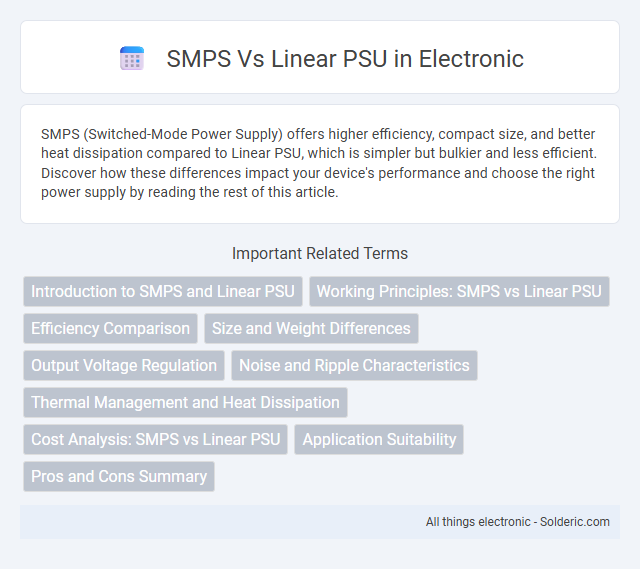SMPS (Switched-Mode Power Supply) offers higher efficiency, compact size, and better heat dissipation compared to Linear PSU, which is simpler but bulkier and less efficient. Discover how these differences impact your device's performance and choose the right power supply by reading the rest of this article.
Comparison Table
| Aspect | SMPS (Switched-Mode Power Supply) | Linear PSU (Linear Power Supply Unit) |
|---|---|---|
| Efficiency | High (80%-90%) | Lower (40%-60%) |
| Size & Weight | Compact and lightweight | Bulky and heavy |
| Heat Generation | Low heat dissipation | High heat dissipation |
| Voltage Regulation | Precise and efficient | Simpler but less efficient |
| Noise | Can produce high-frequency noise | Generally silent |
| Cost | Moderate to high | Lower initial cost |
| Reliability | Complex circuitry, potential failure points | Simpler, generally more robust |
| Applications | Computers, consumer electronics, efficient power delivery | Audio equipment, lab power supplies, noise-sensitive devices |
Introduction to SMPS and Linear PSU
Switched-Mode Power Supplies (SMPS) efficiently convert electrical power using high-frequency switching and energy storage components, offering compact size and high efficiency for various electronic devices. Linear Power Supplies (Linear PSU) regulate voltage by dissipating excess power as heat through linear components, providing stable and low-noise output ideal for sensitive analog circuits. Understanding the operational differences between SMPS and Linear PSU is crucial for selecting the appropriate power solution based on efficiency, size, and output quality requirements.
Working Principles: SMPS vs Linear PSU
Switched-Mode Power Supply (SMPS) operates by rapidly switching transistors on and off to regulate voltage, utilizing high-frequency transformers for efficient energy conversion and reduced heat dissipation. Linear Power Supply (Linear PSU) functions through a transformer-based voltage step-down followed by linear regulation using series pass transistors, resulting in a stable but less efficient output due to continuous power dissipation as heat. SMPS offers higher efficiency and compact size, while Linear PSU provides simpler design and lower electrical noise ideal for sensitive analog circuits.
Efficiency Comparison
SMPS (Switched-Mode Power Supply) offers significantly higher efficiency, typically ranging from 70% to 90%, compared to Linear PSU's average efficiency of 40% to 60%, due to its switch-mode operation and energy-saving design. SMPS reduces energy loss by rapidly switching on and off, minimizing heat generation, while Linear PSUs dissipate excess voltage as heat, leading to lower efficiency and higher power consumption. Choosing an SMPS for Your devices enhances energy efficiency, reduces electricity costs, and improves thermal management.
Size and Weight Differences
SMPS (Switched-Mode Power Supply) units are significantly smaller and lighter than Linear PSUs due to their high-frequency switching technology and compact transformer design. Linear PSUs rely on bulky transformers and heat sinks, resulting in larger size and heavier weight. When selecting a power supply, your choice can impact device portability and installation space because SMPS offers a more compact and lightweight solution.
Output Voltage Regulation
SMPS provides superior output voltage regulation by rapidly adjusting the duty cycle of its switching elements, maintaining stable voltage despite fluctuations in input or load. Linear PSU relies on voltage drop across a transistor to regulate output, resulting in less efficiency and increased heat generation during regulation. Choosing SMPS can enhance your system's performance with precise voltage control and reduced power loss.
Noise and Ripple Characteristics
Switch Mode Power Supplies (SMPS) exhibit higher noise and ripple levels due to high-frequency switching operations, which can affect sensitive audio and RF applications. Linear Power Supplies (Linear PSU) provide cleaner output with minimal noise and ripple, as they regulate voltage through linear regulators without high-frequency switching. For precision equipment requiring low noise and ripple, Linear PSUs are preferred despite lower efficiency and larger size compared to SMPS.
Thermal Management and Heat Dissipation
Switch Mode Power Supplies (SMPS) generate less heat due to higher efficiency, typically above 80%, enabling superior thermal management with smaller heatsinks and reduced cooling requirements. In contrast, Linear Power Supply Units (PSUs) dissipate more heat as voltage drops linearly across a transistor, often resulting in efficiency levels around 50-60%, requiring larger heat sinks and more robust ventilation. Effective heat dissipation in SMPS improves longevity and reliability, making them preferable for compact or high-power applications where thermal constraints are critical.
Cost Analysis: SMPS vs Linear PSU
Switched-Mode Power Supplies (SMPS) generally offer a lower initial cost and higher energy efficiency compared to Linear Power Supply Units (PSU), resulting in reduced electricity bills over time. Linear PSUs tend to have higher heat dissipation, which increases cooling costs and affects long-term operational expenses. While SMPS may require more complex circuitry and design leading to slightly higher manufacturing costs, their overall lifecycle cost remains more economical due to energy savings and compact size.
Application Suitability
Switch Mode Power Supplies (SMPS) are highly suitable for applications requiring high efficiency, compact size, and lightweight design, such as in laptops, LED drivers, and telecommunications equipment. Linear Power Supplies deliver low noise and stable output voltage, making them ideal for sensitive audio, laboratory instruments, and RF applications. Each power supply type's suitability depends on factors like efficiency, thermal management, and noise tolerance specific to the device's operational environment.
Pros and Cons Summary
SMPS (Switched-Mode Power Supply) offers high efficiency, compact size, and better heat dissipation, making it ideal for modern electronics and energy-saving applications. Linear PSU provides low noise and stable voltage output, beneficial for sensitive audio and laboratory equipment but suffers from bulkier design and lower efficiency. Your choice depends on prioritizing energy efficiency and size (SMPS) or simplicity and cleaner power output (Linear PSU).
SMPS vs Linear PSU Infographic

 solderic.com
solderic.com